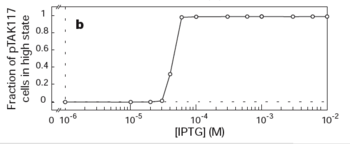Difference between revisions of "CellularMemory:Toggle Switch"
Wideloache (talk | contribs) (→Specific Biological Design) |
Wideloache (talk | contribs) (→Mathematical Modeling) |
||
| Line 13: | Line 13: | ||
==Mathematical Modeling== | ==Mathematical Modeling== | ||
| − | The mathematical model for this paper will not be described in detail because most of the tools for modeling memory networks have already been explained in the [[CellularMemory:Mathematical Models |math modeling]] section. Briefly, two differential equations were created that described the rate of synthesis of each repressor as a function of the concentration of the opposite repressor, cooperativity of repression, and repressor dilution/decay. To calculate the steady states in the system, both of these equations were set equal to 0. This created two [http://en.wikipedia.org/wiki/Nullcline nullclines], the intersection of which represented a steady state and determined the concentration of each repressor in that steady state. This model demonstrates the need to balance promoter strength with repressor strength by tuning the strength of ribosomal binding sites in order to construct a function memory circuit. It also shows that repressor cooperativity is necessary for bistability, as was shown in the [[CellularMemory:Mathematical Models |mathematical modeling]] section. | + | The mathematical model for this paper will not be described in detail because most of the tools for modeling memory networks have already been explained in the [[CellularMemory:Mathematical Models |math modeling]] section. Briefly, two differential equations were created that described the rate of synthesis of each repressor as a function of the concentration of the opposite repressor, the cooperativity of repression, and repressor dilution/decay. To calculate the steady states in the system, both of these equations were set equal to 0. This created two [http://en.wikipedia.org/wiki/Nullcline nullclines], the intersection of which represented a steady state and determined the concentration of each repressor in that steady state. This model demonstrates the need to balance promoter strength with repressor strength by tuning the strength of ribosomal binding sites in order to construct a function memory circuit. It also shows that repressor cooperativity is necessary for bistability, as was shown in the [[CellularMemory:Mathematical Models |mathematical modeling]] section. |
==Results== | ==Results== | ||
Revision as of 19:25, 6 December 2007
Main Page | Biological Designs | Mathematical Models | Toggle Switch | Hysteresis | Permanent Memory | Conclusions | References
|



